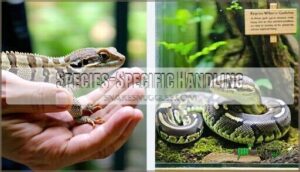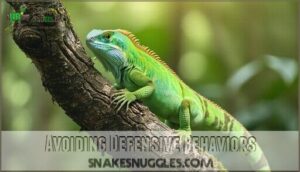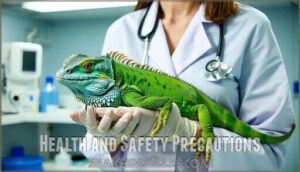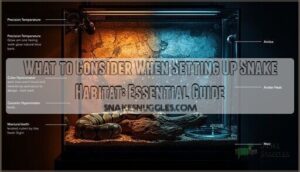This site is supported by our readers. We may earn a commission, at no cost to you, if you purchase through links.
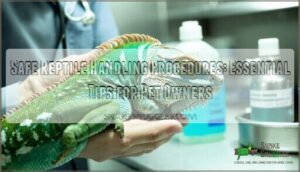 You’ll master safe reptile handling procedures by following three critical steps: always wash your hands before and after contact to prevent Salmonella transmission, move slowly to avoid triggering defensive responses, and support their entire body weight—never grab just the tail or head.
You’ll master safe reptile handling procedures by following three critical steps: always wash your hands before and after contact to prevent Salmonella transmission, move slowly to avoid triggering defensive responses, and support their entire body weight—never grab just the tail or head.
Think of it like holding a delicate piece of equipment; steady support prevents injury to both you and your scaly friend.
Different species require specific techniques, from hook-assisted snake handling to supporting a turtle’s shell properly.
Watch for stress signals like rapid breathing or color changes, which tell you when to back off.
These fundamentals form the foundation of countless specialized techniques that’ll transform you into a confident reptile handler.
Table Of Contents
- Key Takeaways
- Safe Handling Techniques
- Reptile Behavior Understanding
- Handling Different Reptiles
- Health and Safety Precautions
- Choosing Right Reptile Containers
- Frequently Asked Questions (FAQs)
- How do you handle reptiles?
- How do I create a safe reptile handling environment?
- Should you handle a reptile during shedding?
- How do you care for a reptile?
- How do you keep reptiles away from your home?
- How do you handle a lizard & a snake?
- What are the safety precautions used in handling reptiles?
- Do you have to wash your hands after handling reptiles?
- What is the best way to handle reptiles?
- What are the odds of getting Salmonella from a reptile?
- Conclusion
Key Takeaways
- Always wash your hands before and after handling – You’ll prevent Salmonella transmission (found in up to 56% of reptiles) by using soap and warm water for at least 20 seconds during every interaction.
- Support their entire body weight properly – You must use both hands to cradle the reptile’s chest and hindquarters, never grabbing just the tail or head, which can cause injury or trigger defensive responses.
- Move slowly and watch for stress signals – You’ll recognize warning signs like hissing, color changes, or rapid breathing that tell you to back off and end the handling session immediately.
- Use species-specific techniques and equipment – You need different approaches for each type: snake hooks for serpents, full-body support for lizards to prevent tail autotomy, and shell-based grips for turtles.
Safe Handling Techniques
Safe handling techniques form the foundation of successful reptile ownership, protecting both you and your pet from injury or stress.
When you understand your reptile’s natural behaviors and apply proper support methods, you’ll create positive interactions that strengthen your bond while maintaining everyone’s safety.
Reducing Reptile Stress
The key to calm handling lies in recognizing that reptiles experience stress differently than mammals.
Keep sessions under 15 minutes and watch for subtle warning signs that indicate discomfort. Understanding reptile handling tips is essential for a safe and enjoyable experience.
- Environmental Enrichment: Provide hiding spots and basking areas to help your reptile self-regulate stress levels
- Stress Reduction: Use slow, predictable movements and avoid handling during shedding or feeding times
- Reptile Calming: Allow new arrivals to settle for several days before attempting any handling interactions
Proper Body Support
Supporting your reptile’s entire body weight prevents injury and stress during handling.
You’ll need full support techniques that maintain spine alignment – never lift by grabbing limbs or tail alone.
Use both hands for gentle lifting, with one supporting the chest area and another cradling the hindquarters.
This weight distribution approach guarantees proper body restraint while keeping your reptile comfortable and secure throughout the handling session.
Avoiding Tail Autotomy
Many geckos and skinks will drop their tails when grabbed incorrectly—a defense mechanism called autotomy that you can’t reverse.
Never grab reptiles by their tails, as this triggers immediate tail injury and stress.
A dropped tail never grows back the same—handle with care to keep your gecko whole.
Instead, use gentle handling techniques with proper spinal support, and focus on stress reduction through calm movements and reptile restraint methods that avoid tail contact entirely, to prevent autotomy prevention failures, and support their body weight evenly.
Species-Specific Handling
Different reptile species require customized handling approaches based on their unique anatomy and behaviors.
Your species research determines which reptile handling techniques and species-specific precautions you’ll need.
Snake handling demands full-body support, while lizard care focuses on preventing tail autotomy.
Turtle support requires shell-based grips, and each approach follows specific reptile safety protocols.
Reptile owners must consider animal welfare guidelines to guarantee safe handling.
- Bearded dragons typically remain calm during gentle handling, making them perfect starter reptiles
- Monitor lizards can deliver painful bites and whip-like tail strikes when threatened
- Python species vary dramatically – carpet pythons may be defensive while ball pythons stay docile
Reptile Behavior Understanding
Understanding your reptile’s behavior is essential for safe handling and building a positive relationship with your pet.
You’ll need to recognize stress signals like hissing, color changes, or defensive posturing to prevent bites and reduce anxiety during handling sessions.
Recognizing Stress Signals
Watching your reptile’s body language reveals important stress signals that can prevent defensive reactions.
Hissing, puffing up, color changes, and rapid breathing indicate distress.
Recognizing these fear responses helps you adjust your calming techniques before escalation occurs.
| Visual Signs | Behavioral Signs | Physical Signs |
|---|---|---|
| Color darkening | Hiding behavior | Rapid breathing |
| Puffed body | Aggressive posturing | Trembling |
| Flattened stance | Tail whipping | Rigid muscles |
| Wide-open mouth | Escape attempts | Cold skin |
Avoiding Defensive Behaviors
Understanding your reptile’s defensive postures helps prevent unwanted reactions during handling sessions.
When reptiles feel threatened, they’ll display warning signals before escalating to bites or scratches.
Recognizing these early indicators allows you to adjust your approach for better reptile calming and stress reduction.
Key defensive behaviors to watch for:
- Hissing, puffing up, or color changes indicating agitation
- Tail positioning or coiling that suggests preparation for defensive action
- Freezing behavior followed by sudden movements or escape attempts
Gentle handling techniques focusing on animal relaxation prove more effective than forceful restraint, which often triggers stronger defensive responses.
Mastering reptile handling safety is essential for building trust between you and your pet.
Building Trust With Reptiles
Building trust with reptiles requires patience and consistent gentle handling techniques. Start with brief, calm interactions using slow movements. Let your reptile adjust to your presence before physical contact.
Support their body fully during each session, avoiding sudden movements that trigger defensive responses. Successful reptile bonding develops through predictable routines and positive associations.
Your reptile will gradually recognize you’re not a threat when you consistently demonstrate calming methods and respect their comfort zones. This process involves several stages, outlined in the following table:
| Trust Building Stage | Duration | Key Indicators |
|---|---|---|
| Initial Acclimation | 1-2 weeks | Reduced hiding, normal feeding |
| Contact Introduction | 2-4 weeks | Less defensive posturing, calm breathing |
| Regular Handling | 4+ weeks | Relaxed body language, voluntary approach |
By following these stages and maintaining a gentle, consistent approach, you can help your reptile feel secure and develop a strong bond with you, leading to a more relaxed and enjoyable interaction.
Handling Venomous Species
Venomous species demand specialized protocols that exceed standard pet handling approaches.
Professional training becomes non-negotiable when working with hazardous species requiring emergency response preparedness.
Critical Venomous Snake Handling Requirements:
- Snake hooks and restraint tubes – Never attempt direct contact
- Complete protective gear – Long pants, boots, gloves, safety eyewear
- Immediate antivenom access – Emergency protocols practiced regularly
- Professional supervision only – No amateur handling permitted
- Mechanical transfer systems – Eliminate all bite opportunities
Approximately 70% of venomous snakebites occur during capture attempts.
Reptile safety protocols mandate well-lit environments and slow, deliberate movements.
Even deceased venomous species pose risks through reflex envenomation.
Handling Different Reptiles
Each reptile species requires specific handling techniques to guarantee both your safety and their well-being.
You’ll need to master different approaches for snakes, lizards, turtles, and amphibians since what works for one group can stress or injure another, and this is crucial for their well-being.
Snake Handling Procedures
Approach snakes from the side using slow, deliberate movements to avoid startling them.
Snake hooks and handling tools maintain safe distances, especially with venomous species.
Support the snake’s mid-body with both hands, never grabbing the tail or restraining the neck.
For larger snakes, use one handler per three feet.
Watch for defensive postures like S-shaped coiling or hissing—these signal stress and potential strikes.
Proper snake handling techniques prevent venomous bites and guarantee reptile handling safety.
Effective snake handling requires using proper snake hook tools to minimize risks.
Lizard Handling Techniques
Lizards require different handling approaches than snakes due to their unique anatomy and behaviors.
Support the entire body from underneath, never grabbing by the tail to prevent autotomy. Use gentle lizard restraint techniques, keeping hands away from sharp claws that may need trimming.
Provide proper tail support and practice species identification, as bearded dragons accept handling while monitors need protective gear for safe lizard handling procedures.
Understanding reptile handling safety is essential for preventing injuries and ensuring the well-being of both the reptile and the handler, which involves reptile handling safety.
Turtle Handling Methods
Turtles present unique turtle handling guidelines compared to other reptiles. Their protective shells require specific shell support techniques during aquatic handling and turtle transport situations.
Safe Turtle Handling Methods:
- Grip the shell rim – Hold the upper shell’s edges, never the head or limbs
- Support the bottom – Use your other hand underneath during turtle transport
- Watch for scratches – Long claws can cause injury; maintain firm grip
- Avoid the head – Even toothless species have strong keratin edges for biting
- Expect discharge – Glands may release pungent fluid when stressed
Common eastern long-necked turtles remain docile, while short-necked species like Emydura are more mobile and prone to biting. Their surprising mobility means you’ll need confident handling during tank maintenance.
Remember, these "slow" creatures can move faster than expected, making proper turtle care technique essential for reptile handling safety. Keep sessions brief to minimize stress.
Frog and Amphibian Handling
Handling amphibians requires powder-free gloves since their permeable skin absorbs oils and chemicals from human hands.
You’ll need to control moisture levels carefully—keep sessions brief to prevent dehydration while maintaining proper humidity levels.
Use gentle movements for frog transport, supporting their body completely, and never grab limbs or apply pressure, as amphibian bones are fragile and easily damaged, requiring proper handling.
Health and Safety Precautions
Proper health and safety precautions protect both you and your reptile during handling sessions.
These essential measures prevent disease transmission and help you recognize when your pet needs immediate veterinary attention to ensure proper care.
Preventing Salmonella Infection
Salmonella lurks in up to 37% of captive reptiles, making infection control paramount for safe handling.
Every reptile is a potential salmonella carrier—proper hygiene isn’t optional, it’s survival.
You can’t eliminate bacterial transmission through reptile screening—all reptiles should be considered carriers.
Focus on hand hygiene and proper reptile hygiene practices, including avoiding mouth contact, separating food preparation areas, and maintaining clean environments.
These Salmonella risks are manageable with consistent safety protocols, such as proper handling techniques, including safe rodent handling, which are essential to prevent the spread of infection.
Washing Hands Before Handling
Clean hands prevent bacterial transfer that can stress reptiles and compromise your health.
Proper hand hygiene creates a safe handling environment for both you and your pet.
Essential Hand Washing Steps:
- Water Temperature – Use warm water to activate soap effectively without shocking cold-blooded animals
- Soap Usage – Apply antibacterial soap for 20 seconds minimum to eliminate harmful bacteria
- Germ Prevention – Focus on fingernails and between fingers where bacteria accumulate
- Skin Health – Dry hands completely to prevent moisture transfer that encourages bacterial growth
- Reptile Handling Safety Precautions – Wash before and after every interaction to maintain hygiene standards
Recognizing Emergency Signs
Watch for immediate danger signals that demand Emergency Response action.
Lethargy, labored breathing, visible wounds, or abnormal posturing indicate serious health problems requiring reptile first aid.
Temperature extremes, seizures, or bleeding represent critical injury signs needing immediate veterinary attention.
Effective crisis management means recognizing these health alerts quickly—your reptile’s survival depends on swift action when reptile emergency care becomes necessary.
Choosing Right Reptile Containers
Selecting the right container for your reptile isn’t just about size—it’s your first line of defense against escapes that could endanger both your pet and your family.
The wrong enclosure can turn a simple handling session into a stressful chase around your living room, while proper container selection guarantees safe, controlled interactions every time.
Selecting Escape-Proof Enclosures
When choosing escape-proof enclosures, prioritize high-density polyethylene (HDPE) or quality PVC materials for maximum durability.
Your reptile’s safety depends on secure containers with proper ventilation systems and tight-fitting lids that eliminate gaps.
- Peace of mind: Sleep soundly knowing your scaly friend can’t become a midnight escape artist
- Financial protection: Avoid costly veterinary bills from injuries during desperate breakout attempts
- Family safety: Prevent heart-stopping moments when children discover an empty habitat
Select container sizes matching your reptile’s full adult length, ensuring no opening exceeds their head width.
Install fine metal mesh for ventilation while maintaining escape prevention.
Regular reptile enclosure maintenance includes inspecting locks, seals, and potential weak points that compromise your reptile habitat creation efforts.
Ensuring a secure environment requires understanding escape proof designs to protect your pet.
Special Considerations for Snakes
Snake containers require specialized features beyond basic escape-proofing.
You’ll need secure, locking lids since snakes are notorious escape artists who can exploit tiny gaps.
Install proper ventilation without compromising security – snakes need airflow but shouldn’t access vents.
Consider species-specific needs: constrictor care demands sturdy walls that won’t bow under pressure, while venomous species require specialized handling equipment like snake hooks and reptile handling gloves for safe maintenance.
When selecting a container, consider the importance of proper snake container design to guarantee the health and safety of your pet.
Environmental Considerations
Creating ideal reptile environments requires attention to multiple interconnected factors that directly impact your pet’s health and stress levels.
Beyond basic containers, your reptile’s surroundings must replicate natural conditions through precise environmental control.
Consider these key environmental factors:
- Temperature Control: Maintain species-appropriate thermal gradients with reliable heating systems
- Humidity Levels: Monitor moisture content using digital hygrometers for accurate readings
- Lighting Systems: Provide proper UV spectrum lighting to support metabolism and behavior
- Air Quality: Guarantee adequate ventilation management prevents stagnant air and bacterial growth
Your reptile habitat design should balance environmental enrichment with practical maintenance needs, creating spaces where natural behaviors can occur safely.
Maintaining Proper Hygiene
Proper hygiene protocols protect both you and your reptile from dangerous pathogens like salmonella.
Always wash hands thoroughly before and after handling—soap and warm water remain your strongest defense against disease transmission.
Clean tools regularly with disinfectant, sanitize enclosure surfaces weekly, and maintain personal hygiene standards.
Remember: up to 56% of captive snakes carry salmonella bacteria.
Effective reptile cleaning supplies are essential for preventing the spread of disease.
Frequently Asked Questions (FAQs)
How do you handle reptiles?
Always support the reptile’s entire body during handling. Use slow, confident movements to build trust. Wash hands before and after contact. Never grab tails, heads, or limbs directly.
How do I create a safe reptile handling environment?
Up to 70% of reptiles carry Salmonella, making proper setup essential.
You’ll need designated handling areas away from kitchens, proper lighting, secure surfaces, hand-washing stations nearby, and protective equipment like hooks and gloves readily available.
Should you handle a reptile during shedding?
No, you shouldn’t handle reptiles during shedding.
Their skin becomes highly sensitive and painful during this process. Handling can cause discomfort, stress, and potential injury.
Wait until shedding’s complete for everyone’s safety.
How do you care for a reptile?
Your reptile’s life literally depends on getting the basics right.
You’ll need proper temperature gradients, UV lighting, species-specific diet, clean water, appropriate substrate, and regular veterinary checkups to guarantee maximal health.
How do you keep reptiles away from your home?
Seal entry points like gaps under doors, repair screens, and remove food sources.
Keep your yard clean of debris piles where they’d hide.
Use natural deterrents like cinnamon or commercial repellents around vulnerable areas.
How do you handle a lizard & a snake?
Don’t put the cart before the horse when approaching these creatures.
Support lizards’ entire body from underneath, avoiding tail grabs.
For snakes, use hooks first, then support their body’s first third while maintaining spine alignment throughout handling.
What are the safety precautions used in handling reptiles?
Always wash your hands before and after contact to prevent salmonella transmission.
Support the reptile’s entire body, avoid grabbing tails or heads, use protective gear when needed, and limit handling sessions to prevent stress and temperature drops.
Do you have to wash your hands after handling reptiles?
Better safe than sorry—you absolutely must wash your hands after handling reptiles.
Up to 56% of captive snakes carry Salmonella, making thorough handwashing with soap your most effective defense against infection.
What is the best way to handle reptiles?
Support your reptile’s body completely, move slowly and confidently, and avoid grabbing the head or tail.
Use hooks for snakes, limit sessions to fifteen minutes, and always wash hands before and after handling.
What are the odds of getting Salmonella from a reptile?
Playing Russian roulette with your pet’s bacteria? You’re facing roughly 35% odds of encountering Salmonella from captive reptiles, with snakes carrying the highest risk at 56% and lizards exceeding 36% prevalence rates.
Conclusion
Mastering safe reptile handling procedures transforms you from a nervous beginner into a confident caretaker overnight—well, maybe not quite overnight, but close.
You’ve learned that proper technique isn’t just about avoiding bites; it’s about respecting these remarkable creatures while keeping yourself healthy.
Remember: slow movements, full body support, and thorough hand hygiene aren’t suggestions—they’re non-negotiable safety protocols.
With consistent practice and patience, you’ll develop the intuitive understanding that separates experienced handlers from well-meaning amateurs.
- https://pmc.ncbi.nlm.nih.gov/articles/PMC10562597/
- https://www.calverthealth.org/healththreats/diseases/salmonella.htm
- https://www.oregon.gov/oha/PH/DISEASESCONDITIONS/DISEASESAZ/Documents/reptile.pdf
- https://www.hpsc.ie/a-z/zoonotic/reptilesandrisksofinfectiousdiseases/
- https://todaysveterinarynurse.com/behavior/low-stress-veterinary-visits-for-reptiles/




